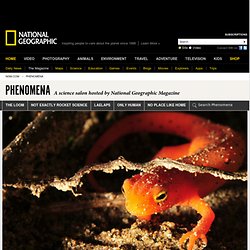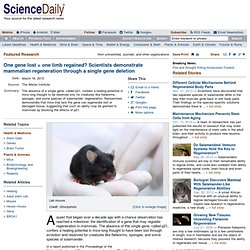

3D Printing Body Parts & Drugs. Human organs 'could be grown in animals within a year' The cell that could hold the secret to limb regeneration. Researchers have identified a cell that aids limb regrowth in Salamanders.

Macrophages are a type of repairing cell that devour dead cells and pathogens, and trigger other immune cells to respond to pathogens. In humans, they're also important to muscle repair, which led Dr. James Godwin, of the Australian Regenerative Medicine Institute (ARMI) at Monash University, to research whether the macrophages found inside Salamanders are related to the animal's ability to regenerate limbs. The cells could release chemicals to trigger regeneration Salamanders are unique in the vertebrate world as they're capable of repairing their hearts, tails, spinal cords, brain, and regrowing limbs.
Although understanding the Salamander's abilities may one day lead to impossible-sounding feats like limb regeneration in humans, there are more-immediate benefits that could come from the research. Will we ever regenerate limbs? Here’s the 16th piece from my BBC column In Spider-Man comics, scientist Curt Connors injects himself with a serum based on lizard DNA and re-grows his amputated arm.

He also transforms into a giant humanoid lizard and becomes evil. Unfortunate side-effects aside, the Lizard’s story reflects a real and longstanding scientific quest – to understand the extraordinary regenerative powers of animals, and duplicate them in humans. If I cut my arm off, I will end up with a permanent stump that’s covered in scar tissue. By contrast, if a newt or salamander loses its leg, it will grow a new one. Healing powers of this kind were first discovered in 1740, when Abraham Trembley discovered that a green pond animal could regenerate its tentacle-crowned head if it was amputated. But despite centuries of research, we’re a long way from even understanding how regeneration works, much less replicating the feat in our own bodies. Making things worse, salamander genomes are oddly bloated. Healing acts. Different cell mechanisms behind regenerated limbs. Stem Cell Discovery Could Help Regrow Fingers. Mammals can regenerate the very tips of their fingers and toes after amputation, and now new research shows how stem cells in the nail play a role in that process.

A study in mice, detailed online today (June 12) in the journal Nature, reveals the chemical signal that triggers stem cells to develop into new nail tissue, and also attracts nerves that promote nail and bone regeneration. NEWS: Excellent Idea of the Day: Stem Cells for Babies The findings suggest nail stem cells could be used to develop new treatments for amputees, the researchers said. [Inside Life Science: Once Upon a Stem Cell] In mice and people, regenerating an amputated finger or toe involves regrowing the nail. To understand why these stem cells are crucial to regeneration, researchers turned to mice.
They found that the signals that guided the stem cells' development into nail cells were vital to regenerating amputated digits. BLOG: Olympic Horse Used Stem Cell Therapy Get more from LiveScience. One gene lost = one limb regained? Scientists demonstrate mammalian regeneration through a single gene deletion. A quest that began over a decade ago with a chance observation has reached a milestone: the identification of a gene that may regulate regeneration in mammals.

The absence of this single gene, called p21, confers a healing potential in mice long thought to have been lost through evolution and reserved for creatures like flatworms, sponges, and some species of salamander. In a report published in the Proceedings of the National Academy of Sciences, researchers from The Wistar Institute demonstrate that mice that lack the p21 gene gain the ability to regenerate lost or damaged tissue. Newt sequencing may set back efforts to regrow human limbs. Martin Shields/Science Photo Library The Eastern, or red-spotted, newt may have evolved the ability to regenerate organs and limbs in relatively recent times.

The ability of some animals to regenerate tissue is generally considered to be an ancient quality of all multicellular animals. A genetic analysis of newts, however, now suggests that it evolved much more recently. Tiny and delicate it may be, but the red spotted newt ( Notophthalmus viridescens) has tissue-engineering skills that far surpass the most advanced biotechnology labs. Possibility Of First Head Transplant Fraught With Ethical And Medical Dilemmas. Two-arm transplant achieved at Hopkins. COURTESY OF JOHNS HOPKINS MEDICINEHopkins surgeons succeed in accomplishing rare, double arm transplant. The operation was a very rare, complex one performed by sixteen Hopkins surgeons over a span of thirteen hours, four times longer than a typical coronary bypass surgery.
On December 18, 2012 veteran Brendan Marrocco, who lost all four limbs while serving in Iraq, received a double arm transplant surgery at the Hopkins Hospital. Preparations for the surgery began a year and a half before it even reached the operating room. To ensure its success, which involved connecting bones, muscles, nerves and blood vessels of the arms to the donated limbs, the surgical team underwent many rehearsals of the procedure on cadavers. “We had to plan an operation tailor made for [the patient’s] anatomy,” said Jaimie Shores, clinical director of hand and upper extremity transplantation at Johns Hopkins Hospital.